Popular categories
Looking for a yarn?
Autumn Leaf
Knitted DROPS shawl with lace pattern and leaves in "Lace" or "BabyAlpaca Silk".
DROPS design: Pattern no la-025
Yarn group A
----------------------------------------------------------
Measurements: approx. 70 cm mid back, and approx. 140 cm along the top.
Materials:
DROPS LACE from Garnstudio
100 g colour no 3620, red
Or use:
DROPS BABYALPACA SILK from Garnstudio
Approx. 350 g colour no 3609, red
DROPS CIRCULAR NEEDLE (80 cm) SIZE 3 mm – NOTE: Read knitting tension below!
KNITTING TENSION:
This garment is to be soaked and blocked/stretched to size afterwards so the knitting tension is not that important. But to get a sense of whether you are working too loose/tight, work a test on needle size 3 mm in stocking st and get approx. 24 sts x 32 rows in stocking st = 10 x 10 cm.
-------------------------------------------------------
Alternative Yarn – See how to change yarns here
Yarn Groups A to F – Use the same pattern and change the yarn here
Yarn usage using an alternative yarn – Use our yarn converter here
-------------------------------------------------------
- English (UK/cm)
- Česky
- Dansk
- Deutsch
- Eesti keel
- English (US/in)
- Español
- Français
- Íslenska
- Italiano
- Magyar
- Nederlands
- Norsk
- Polski
- Português
- Suomi
- Svenska
- English (UK/cm), Bulgaria
- English (UK/cm), Croatia
- English (UK/cm), Greece
- English (UK/cm), Latvia
- English (UK/cm), Lithuania
- English (UK/cm), Romania
- English (UK/cm), Slovenia
- Česky, Slovakia
Pattern instructions
K all rows. 1 ridge = 2 rows K.
PATTERN:
See diagrams A.1 to A.23. The diagrams show all rows in pattern seen from RS.
KNITTING TIP:
The shawl can be knitted with other needle sizes than those given here. Use smaller needles for a smaller shawl and larger needles for a larger shawl. Stretch the shawl to side at the end and even out possible uneven places.
SHAPING:
When using another yarn than Lace from yarn group A, there is no need to stretch to measurements, but place it gently out in shape. Leave to dry. Repeat the process when the garment has been washed.
----------------------------------------------------------
SHAWL:
Worked back and forth on circular needle to make room for all the sts. READ KNITTING TIP! Cast on 9 sts with Lace or BabyAlpaca Silk on circular needle size 3 mm and K 1 row from WS. Work in GARTER ST - see explanation above as follows (= RS): K 3, 1 YO, K 1, 1 YO, K 1, 1 YO, K 1, 1 YO, K 3 = 13 sts. Insert 1 marker in the middle st and move it upwards when working.
Then inc 4 sts on every row from RS as follows: Inc 1 st inside 3 edge sts in each side and 1 st on each side of mid st. Inc like this 5 times in total, there are 33 sts on the needle.
Now work according to diagram A.1 as follows: 3 edge sts in garter st, A.1 over the next 13 sts, 1 st in stocking st (= mid st, always worked in stocking st), A.1 over 13 sts and 3 edge sts in garter st. Work A.1 1 time vertically = 61 sts on needle (i.e. 30 sts on each side of mid st).
Work according to diagram A.2-A.4 as follows: 3 edge sts in garter st, A.2 over 7 sts, A.3 over 14 sts, A.4 over 6 sts, 1 mid st, A.2 over 7 sts, A.3 over 14 sts, A.4 over 6 sts and 3 edge sts in garter st. When A.2-A.4 have been worked 1 time vertically, there is room for 1 more repetition of A.3 between A.2 and A.4. Continue to work according to diagram until diagram A.2-A.4 have been worked 3 times in total vertically = 145 sts on needle (i.e. 72 sts on each side of mid st).
Work according to diagram A.5-A.10 as follows: 3 edge sts in garter st, A.5 over 11 sts, repeat A.6 until 10 sts remain before mid st, A.7 over 10 sts, 1 mid st, A.8 over 10 sts, repeat A.9 until 14 sts remain, A.10 over 11 sts and 3 edge sts in garter st. Work A.5-A.10 1 time vertically = 217 sts on needle (i.e. 108 sts on each side of mid st).
Work diagram A.11-A.16 as follows: 3 edge sts in garter st, A.11 over 4 sts, repeat A.12 until 5 sts remain before mid st, A.13 over 5 sts, 1 mid st, A.14 over 5 sts, repeat A.15 until 7 sts remain, A.16 over 4 sts and 3 edge sts in garter st. Work diagram A.11-A.16 1 time vertically = 267 sts on needle (i.e. 133 sts on each side of mid st).
Work diagram A.17-A.23 as follows: 3 edge sts in garter st, A.17 over 4 sts, repeat A.18 until 6 sts remain before mid st, A.19 over 3 st, A.20 over 7 sts (mid st is in the middle of these sts), A.21 over 3 st, repeat A.22 until 7 sts remain, A.23 over 4 sts and 3 edge sts in garter st. When diagrams have been worked 1 time vertically, loosely cast off. NOTE: Work double YOs on last row in diagram as follows when casting off: K 1st YO, K 2nd YO twisted.
BLOCKING:
Place the shawl in lukewarm water until it is soaking wet. Carefully squeeze the water out of the shawl - do not twist the shawl - then roll the shawl in a towel and squeeze to remove more water - the shawl will now only be moist. When using BabyAlpaca Silk – READ SHAPING!
Place the shawl on a carpet or mattress - carefully stretch it out to size and fasten it with pins, pull in the tips of leaves along the cast-off edge. Leave to dry. Repeat the process when the shawl has been washed.
Diagram

|
= K from RS, P from WS |

|
= K 2 tog |

|
= slip 1 st as if to P (yarn behind work), K 1, psso |

|
= 1 YO between 2 sts |

|
= slip 1 st as if to P (yarn behind work), K 2 tog, psso |

|
= 2 YOs between 2 sts, on next row K 1st YO, K 2nd YO twisted while casting it off |


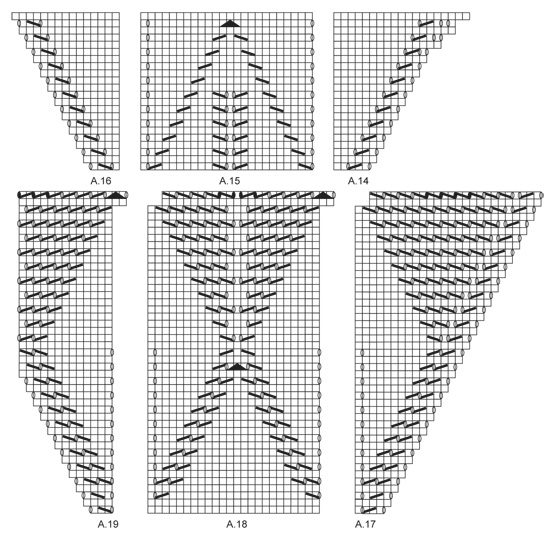

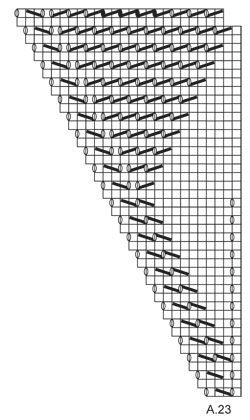
What can you do with our patterns? You can share DROPS patterns online, using the pattern original picture, materials, name and number. But you are NOT ALLOWED to reproduce the complete pattern digitally in any way. Yarn stores are welcome to use the DROPS pattern database to promote the sale of our assortment. You can print out our patterns, make as many copies as you’d like. The only thing we ask is that you don't make any changes / additions to the original printed document. And that the patterns according to the DROPS philosophy are given out to the consumers for free. Editorials that wish to publish our patterns in printed books or magazines can contact us for more information. The sale of garments based on DROPS patterns is permitted as long as they are sold as single items or per order. Further commercial use of the patterns is not permitted. It has to be clearly stated that the garment is made based on a design from DROPS DESIGN. The use of clothing labels of which DROPS DESIGN forms part is conditioned by the inclusion of the following text: “A DROPS DESIGN made by …..”. The use of DROPS photos for marketing purposes/sales is only permitted in connection with the use/sale of DROPS products. The photos may not be cut or edited and the logo should be clearly visible.
We reserve the right to withdraw the permission for use of our patterns at any time, notwithstanding the reason.
Each of our patterns has specific tutorial videos to help you.
These step-by-step tutorials might also help you:
Why is the knitting/crochet tension so important?
Knitting tension is what determines the final measurements of your work, and is usually measured per 10 x 10 cm. It is provided like so: number of stitches in width x number of rows in height - eg: 19 stitches x 26 rows = 10 x 10 cm.
The knitting tension is very individual; some people knit/crochet loosely while others work tightly. You adjust the knitting tension with the needle size, which is why the suggested needle size is only meant as a guide! You need to adjust this (up or down) to ensure that YOUR knitting tension matches the knitting tension provided in the pattern. If you work with a different knitting tension than provided you will have a different yarn consumption, and your work will have different measurements than what the pattern suggests.
The knitting tension also determines which yarns can replace each other. As long as you achieve the same knitting tension you can replace one yarn with another.
See DROPS lesson: How to measure your tension/gauge
See DROPS video: How to make a gauge tension swatch
How do I know how many balls of yarn I need?
The required amount of yarn is provided in grams, eg: 450 g. To calculate how many balls you’ll need you first need to know how many grams are in 1 ball (25g, 50g or 100g). This information is available if you click on the individual yarn quality on our pages. Divide the amount required with the amount of each ball. For example, if each ball is 50g (the most common amount), the calculation will be as follows: 450 / 50 = 9 balls.
Can I use a different yarn than what the pattern suggests?
The important thing when changing from one yarn to another is that the knitting/crochet tension remains the same. This is so that the measurements of the finished piece will be the same as on the sketch provided. It is easier to achieve the same knitting tension using yarns from the same yarn group. It is also possible to work with multiple strands of a thinner yarn to achieve the knitting tension of a thicker one. Please try our yarn converter. We recommend you to always work a test swatch.
Please NOTE: when changing yarn the garment might have a different look and feel to the garment in the photo, due to individual properties and qualities of each yarn.
See DROPS lesson: Can I use a different yarn than the one mentioned in the pattern?
What are the yarn groups?
All our yarns are categorised into yarn groups (from A to F) according to thickness and knitting tension – group A contains the thinnest yarns and group F the thickest. This makes it easier for you to find alternative yarns to our patterns, should you wish to switch yarn. All yarns within the same group have a similar knitting tension and can easily replace each other. However, different yarn qualities have different structures and properties which will give the finished work a unique look and feel.
How do I use the yarn calculator?
At the top of all our patterns you’ll find a link to our yarn calculator, which is a helpful tool should you wish to use a different yarn than suggested. By filling in the yarn quality you wish to replace, the amount (in your size) and number of strands, the calculator will present good alternative yarns with the same knitting tension. Additionally it will tell you how much you’ll require in the new qualities and whether you’ll need to work with multiple strands. Most skeins are 50g (some are 25g or 100g).
If the pattern is worked with multiple colours, every colour will have to be calculated separately. Similarly, if the pattern is worked with several strands of different yarns (for example 1 strand Alpaca and 1 strand Kid-Silk) you will have to find alternatives for each, individually.
Why do you show discontinued yarns in the patterns?
Since different yarns have different qualities and textures we have chosen to keep the original yarn in our patterns. However, you can easily find options among our available qualities by using our yarn calculator, or simply pick a yarn from the same yarn group.
It is possible that some retailers still have discontinued yarns in stock, or that someone has a few skeins at home that they would like to find patterns for.
The yarn calculator will provide both alternative yarn as well as required amount in the new quality.
What size should I knit?
If you think it's hard to decide what size to make, it can be a good idea to measure a garment you own already and like the size of. Then you can pick the size by comparing those measures with the ones available in the pattern's size chart.
You'll find the size chart at the bottom of the pattern.
See DROPS lesson: How to read size chart
Why do I get the wrong knitting tension with the suggested needle size?
The needle size provided in the pattern serves only as a guide, the important thing is to follow the knitting tension. And since knitting tension is very individual, you will have to adjust the needle size to ensure that YOUR tension is the same as in the pattern – maybe you’ll have to adjust 1, or even 2 needle sizes, up or down to achieve the correct tension. For this, we recommend that you work test swatches.
Should you work with a different knitting tension than the one provided, the measurements of the finished garment might deviate from the measurement sketch.
See DROPS lesson: How to measure your tension/gauge
See DROPS video: How to make a tension/gauge swatch
Why is the pattern worked top-down?
Working a garment top-down provides more flexibility and room for personal adjustment. For example it is easier to try the garment on while working, as well as making adjustments to length of yoke and shoulder caps.
The instructions are carefully explaining every step, in the correct order. Diagrams are adjusted to the knitting direction and are worked as usual.
How do I work according to a knitting diagram?
The diagram depicts all rows/rounds, and every stitch seen from the right side. It is read from bottom to top, from right to left. 1 square = 1 stitch.
When working back and forth, every other row is worked from the right side and every other row is worked from the wrong side. When working from the wrong side, the diagram will have to be worked reversed: from left to right, knit stitches are purled, purl stitches are knit etc.
When working in the round every round is worked from the right side and the diagram are worked from right to left on all rounds.
See DROPS lesson: How to read knitting diagrams
How do I work according to a crochet diagram?
The diagram depicts all rows/rounds, and every stitch seen from the right side. It is worked from bottom to top, from right to left.
When working back and forth every other row is worked from the right side: from right to left and every other row is worked from the wrong side: from left to right.
When working in the round, every row in the diagram are worked from the right side, from right to left.
When working a circular diagram you start in the middle and work your way outwards, counter clockwise, row by row.
The rows usually start with a given number of chain stitches (equivalent to the height of the following stitch), this will either be depicted in the diagram or explained in the pattern.
See DROPS lesson: How to read crochet diagrams
How do I work several diagrams simultaneously on the same row/round?
Instructions for working several diagrams after each other on the same row/round, will often be written like so: “work A.1, A.2, A.3 a total of 0-0-2-3-4 times". This means you work A.1 once, then A.2 is worked once, and A.3 is repeated (in width) the number of times provided for your size – in this case like so: S = 0 times, M = 0 times, L=2 times, XL= 3 times and XXL = 4 times.
The diagrams are worked as usual: begin with the first row in A.1, then work the first row in A.2 etc.
See DROPS lesson: How to read knitting diagrams
See DROPS lesson: How to read crochet diagrams
Why are the sleeves shorter in larger sizes?
The total width of the garment (from wrist-to-wrist) will be larger in the larger sizes, despite the actual sleeves being shorter. The larger sizes have longer sleeve caps and wider shoulders, so there will be a good fit in all sizes.
Where on the garment is the length measured?
The measurement sketch/schematic drawing provides information regarding the full length of the garment. If it’s a jumper or a jacket the length is measured from the highest point on the shoulder closest to the neckline, and straight down to the bottom of the garment. It is NOT measured from the tip of shoulder. Similarly, the length of yoke is measured from the highest point on the shoulder and down to where yoke is split into body and sleeves.
On a jacket measures are never taken along bands, unless specifically stated. Always measure inside band stitches when measuring the length.
See DROPS lesson: How to read a schematic drawing
What is a repeat?
Diagrams are often repeated on the round or in height. 1 repeat is the diagram the way it appears in the pattern. If it says to work 5 repeats of A.1 in the round, then you work A.1 a total of 5 times after/next to each other in the round. If it says to work 2 repeats of A.1 vertically/in height you work the entire diagram once, then begin again at the start and work the entire diagram one more time.
Why does the piece start with more chain stitches than it’s worked with?
Chain stitches are slightly narrower than other stitches and to avoid working the cast-on edge too tight, we simply chain more stitches to begin with. The stitch count will be adjusted on the following row to fit the pattern and measurement sketch.
Why increase before the rib edge when the piece is worked top-down?
The rib edge is more elastic and will contract slightly compared to, for example, stocking stitch. By increasing before the rib edge, you avoid a visible difference in width between the rib edge and the rest of the body.
Why increase in the cast-off edge?
It’s very easy to cast off too tightly, and by making yarn overs while casting off (and simultaneously casting these off) you avoid a too tight cast off edge.
See DROPS video: How to bind off with yarn overs (yo)
How do I increase/decrease on every 3rd and 4th row/round alternately?
To achieve an even increase (or decrease) you can increase on, for example: every 3rd and 4th row alternately, like so: work 2 rows and increase on the 3rd row, work 3 rows and increase on the 4th. Repeat this until the increase is complete.
See DROPS lesson: Increase or decrease 1 st on every 3rd and 4th row alternately
How can I work a jacket in the round instead of back and forth?
Should you prefer to work in the round instead of back and forth, you may of course adjust the pattern. You’ll need to add steeks mid-front (usually 5 stitches), and follow the instructions. When you would normally turn and work from the wrong side, simply work across the steek and continue in the round. At the end you’ll cut the piece open, pick up stitches to work bands, and cover the cut edges.
See DROPS video: How to knit steeks and cut open
Can I work a jumper back and forth instead of in the round?
Should you prefer to work back and forth instead of in the round, you may of course adjust the pattern so you work the pieces separately and then assemble them at the end. Divide the stitches for the body in 2, add 1 edge stitch in each side (for sewing) and work the front and back pieces separately.
See DROPS lesson: Can I adapt a pattern for circular needles into straight needles?
Why is the pattern slightly different than what I see in the photo?
Pattern repeats can vary slightly in the different sizes, in order to get the correct proportions. If you’re not working the exact same size as the garment in the photo, yours might deviate slightly. This has been carefully developed and adjusted so that the complete impression of the garment is the same in all sizes.
Make sure to follow instructions and diagrams for your size!
How do I make a women’s size garment into a men’s size one?
If you have found a pattern you like which is available in women’s size it’s not very difficult to convert it to men’s size. The biggest difference will be the length of sleeves and body. Start working on the women size that you think would fit across the chest. The additional length will be worked right before you cast off for the armhole/sleeve cap. If the pattern is worked top-down you can add the length right after the armhole or before the first decrease on sleeve.
Regarding additional yarn amount, this will depend on how much length you add, but it is better with a skein too many than too few.
How do I prevent a hairy garment from shedding?
All yarns will have excess fibres (from production) that might come off as lint or shedding. Brushed yarns (ie hairier yarns) have more of these loose, excess fibres, causing more shedding.
Shedding also depends on what is worn under or over the garment, and whether this pulls at the yarn fibres. It’s therefore not possible to guarantee that there will be no shedding
Below are some tips on how to get the best result when working with hairier yarns:
1. When the garment is finished (before you wash it) shake it vigorously so the looser hairs come off. NOTE: do NOT use a lint roller, brush or any method that pulls at the yarn.
2. Place the garment in a plastic bag and put it in your freezer - the temperature will cause the fibres to become less attached to each other, and excess fibres will come off easier.
3. Leave in the freezer for a few hours before taking it out and shaking it again.
4. Wash the garment according to the instructions on the yarn label.
Why does my garment pill?
Pilling is a natural process that happens to even the most exclusive of fibers. It's a natural sign of wear and tear that is hard to avoid, and that is most visible in high friction areas of your garment like a sweater's arms and cuffs.
You can make your garment look as new by removing the pilling, using a fabric comb or a pill/lint remover.
In the meantime, you can read the questions and answers that others have left to this pattern or join the DROPS Workshop on Facebook to get help from fellow knitters/crocheters!
You might also like...
Autumn Leaf |
|||||||||||||||||||
|
|
|||||||||||||||||||
Knitted DROPS shawl with lace pattern and leaves in "Lace" or "BabyAlpaca Silk".
DROPS 164-41 |
|||||||||||||||||||
|
GARTER ST (back and forth): K all rows. 1 ridge = 2 rows K. PATTERN: See diagrams A.1 to A.23. The diagrams show all rows in pattern seen from RS. KNITTING TIP: The shawl can be knitted with other needle sizes than those given here. Use smaller needles for a smaller shawl and larger needles for a larger shawl. Stretch the shawl to side at the end and even out possible uneven places. SHAPING: When using another yarn than Lace from yarn group A, there is no need to stretch to measurements, but place it gently out in shape. Leave to dry. Repeat the process when the garment has been washed. ---------------------------------------------------------- SHAWL: Worked back and forth on circular needle to make room for all the sts. READ KNITTING TIP! Cast on 9 sts with Lace or BabyAlpaca Silk on circular needle size 3 mm and K 1 row from WS. Work in GARTER ST - see explanation above as follows (= RS): K 3, 1 YO, K 1, 1 YO, K 1, 1 YO, K 1, 1 YO, K 3 = 13 sts. Insert 1 marker in the middle st and move it upwards when working. Then inc 4 sts on every row from RS as follows: Inc 1 st inside 3 edge sts in each side and 1 st on each side of mid st. Inc like this 5 times in total, there are 33 sts on the needle. Now work according to diagram A.1 as follows: 3 edge sts in garter st, A.1 over the next 13 sts, 1 st in stocking st (= mid st, always worked in stocking st), A.1 over 13 sts and 3 edge sts in garter st. Work A.1 1 time vertically = 61 sts on needle (i.e. 30 sts on each side of mid st). Work according to diagram A.2-A.4 as follows: 3 edge sts in garter st, A.2 over 7 sts, A.3 over 14 sts, A.4 over 6 sts, 1 mid st, A.2 over 7 sts, A.3 over 14 sts, A.4 over 6 sts and 3 edge sts in garter st. When A.2-A.4 have been worked 1 time vertically, there is room for 1 more repetition of A.3 between A.2 and A.4. Continue to work according to diagram until diagram A.2-A.4 have been worked 3 times in total vertically = 145 sts on needle (i.e. 72 sts on each side of mid st). Work according to diagram A.5-A.10 as follows: 3 edge sts in garter st, A.5 over 11 sts, repeat A.6 until 10 sts remain before mid st, A.7 over 10 sts, 1 mid st, A.8 over 10 sts, repeat A.9 until 14 sts remain, A.10 over 11 sts and 3 edge sts in garter st. Work A.5-A.10 1 time vertically = 217 sts on needle (i.e. 108 sts on each side of mid st). Work diagram A.11-A.16 as follows: 3 edge sts in garter st, A.11 over 4 sts, repeat A.12 until 5 sts remain before mid st, A.13 over 5 sts, 1 mid st, A.14 over 5 sts, repeat A.15 until 7 sts remain, A.16 over 4 sts and 3 edge sts in garter st. Work diagram A.11-A.16 1 time vertically = 267 sts on needle (i.e. 133 sts on each side of mid st). Work diagram A.17-A.23 as follows: 3 edge sts in garter st, A.17 over 4 sts, repeat A.18 until 6 sts remain before mid st, A.19 over 3 st, A.20 over 7 sts (mid st is in the middle of these sts), A.21 over 3 st, repeat A.22 until 7 sts remain, A.23 over 4 sts and 3 edge sts in garter st. When diagrams have been worked 1 time vertically, loosely cast off. NOTE: Work double YOs on last row in diagram as follows when casting off: K 1st YO, K 2nd YO twisted. BLOCKING: Place the shawl in lukewarm water until it is soaking wet. Carefully squeeze the water out of the shawl - do not twist the shawl - then roll the shawl in a towel and squeeze to remove more water - the shawl will now only be moist. When using BabyAlpaca Silk – READ SHAPING! Place the shawl on a carpet or mattress - carefully stretch it out to size and fasten it with pins, pull in the tips of leaves along the cast-off edge. Leave to dry. Repeat the process when the shawl has been washed. |
|||||||||||||||||||
Diagram explanations |
|||||||||||||||||||
|
|||||||||||||||||||

|
|||||||||||||||||||

|
|||||||||||||||||||

|
|||||||||||||||||||

|
|||||||||||||||||||

|
|||||||||||||||||||
|
Have you made this or any other of our designs? Tag your pictures in social media with #dropsdesign so we can see them! Do you need help with this pattern?You'll find tutorial videos, a Comments/Questions area and more by visiting the pattern on garnstudio.com. © 1982-2024 DROPS Design A/S. We reserve all rights. This document, including all its sub-sections, has copyrights. Read more about what you can do with our patterns at the bottom of each pattern on our site. |
|||||||||||||||||||
With over 40 years in knitting and crochet design, DROPS Design offers one of the most extensive collections of free patterns on the internet - translated to 17 languages. As of today we count 304 catalogues and 11422 patterns - 11422 of which are translated into English (UK/cm).
We work hard to bring you the best knitting and crochet have to offer, inspiration and advice as well as great quality yarns at incredible prices! Would you like to use our patterns for other than personal use? You can read what you are allowed to do in the Copyright text at the bottom of all our patterns. Happy crafting!








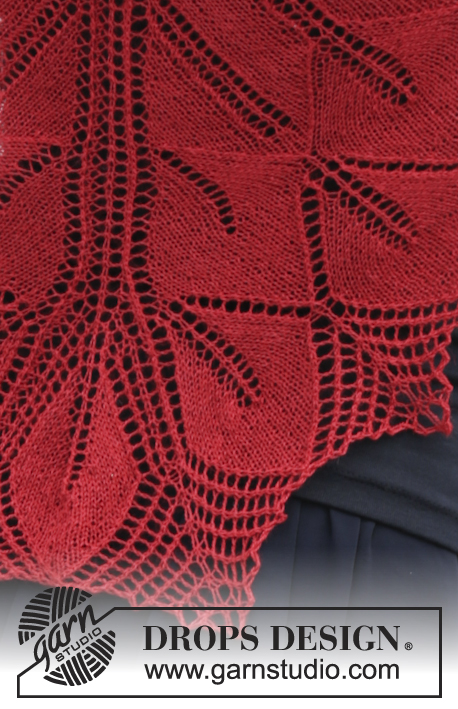

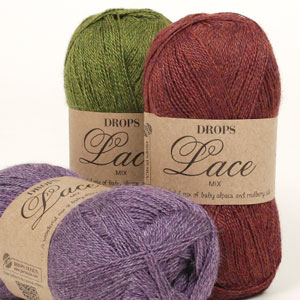





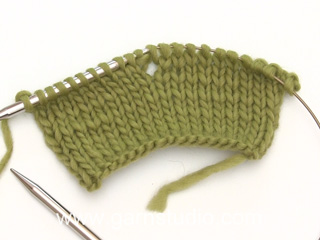


























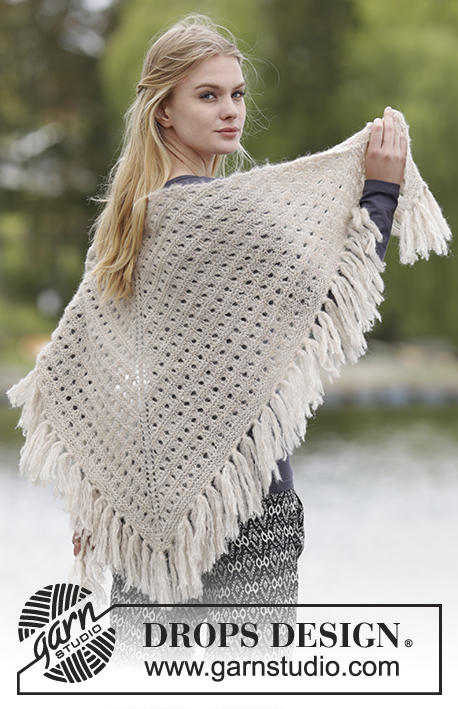






Comments / Questions (55)
Liebes Drops - Team, Ich habe den Denk - Fehler gefunden. In der 3. Reihe endet man mit 11 Maschen, anstatt zuvor mit 10 Maschen vor der Mittel Masche. Einfacher wäre es gewesen, wenn dies in der Anleitung vermerkt wäre. Aber vielleicht hilft der Hinweis anderen Stricker - innen. LG Petra
24.10.2019 - 17:39Hallo, ich bin jetzt in der 3. Reihe und die Anzahl der Maschen ist korrekt ( je 74 pro Nadel +1 MM). In der 3. Reihe habe ich allerdings 12, anstatt 10 M vor der MM . D.h. 2 Maschen zu viel.... Wo liegt der Fehler? LG Petra
21.10.2019 - 18:26DROPS Design answered:
Liebe Petra, es ist etwas schwierig um Ihnen so zu beantworten, eine gute Idee ist Markierer zwischen jedem Diagram einzusetzen, so können Sie bei jeder Reihe die Maschenanzahl prüfen. Viel Spaß beim stricken!
22.10.2019 - 10:35Hallo, ich bin beim Diagramm A5 -A10 , in der 3. Reihe. Beidseitig der Mittel Masche habe ich je 74 Maschen auf der Nadel. Beim Stricken nach der Strickschrift, habe ich auf beiden Seiten je 2 Maschen, die ich nicht integrieren kann. Wo könnte der Fehler liegen? Leider komme ich nun nicht mehr weiter. Für eine rasche Antwort, wäre ich sehr dankbar. LG Petra
20.10.2019 - 19:26DROPS Design answered:
Liebe Petra, bei den Diagrammen A.5, A.7, A.9 und A.10 nehmen Sie je 1 Masche = 4 Maschen pro Hinreihen werden zugenommen. Nach der 2. Reihe, haben Sie dann 145 +4= 149 M (= 74 M auf beiden Seiten von der mittelren Maschen). Viel Spaß beim stricken!
21.10.2019 - 11:17Se cierra del lado derecho o del revés ?
10.05.2019 - 04:48DROPS Design answered:
Hola Susana. Se cierra la labor según el diagrama, por el lado derecho.
18.05.2019 - 20:351000 Tak for svar
07.02.2019 - 19:29Har jeg ret i at et mønster strikkes fra Højre mod Venstre blev lige pludselig i tvivl Med venlig hilsen Judithe Andersen
07.02.2019 - 00:18DROPS Design answered:
Hej Judith, ja det stemmer, du strikker fra nederst i højre hjørne af diagrammet fra retsiden og næste pind strikkes fra vrangen ifølge 2.pind fra venstre i diagrammet (dvs i vrang da diagrammet ses fra retsiden). God fornøjelse!
07.02.2019 - 15:54Désolée, je viens de m'en apercevoir. L'avantage, ayant du défaire une dizaine de fois mon ouvrage, cette laine se tient bien !
05.09.2018 - 19:47Bonjour\r\nEn lisant le commentaire de Geoffroy, du 16.05.2016 - 22:28: \r\nJe suis d\'accord.\r\nJe n\'ai tricoté que quelques rangs, mais ça ne correspond pas à la photo. \r\nPar exemple, à la pointe, c\'est à dire, en début d\'ouvrage, je vois sur la photo 7 jeté successifs, entre des mailles ensembles (ou surjet), alors qu\'il est indiqué de tricoté 3 mailles au point mousse dans les explications....
31.08.2018 - 23:33DROPS Design answered:
Bonjour Pascale, le châle se tricote de haut en bas, c'est-à-dire que l'on commence par 9 mailles seulement et on va augmenter 4 m tous les 2 rangs sur l'endroit pour former le triangle. La pointe sera formée par la maille centrale (= avec 1 augm de chaque côté de cette maille jersey). Bon tricot!
04.09.2018 - 11:33Merci pour votre aide. Je rabats donc sur l'envers à l'envers mais les explications précisent "tricoter le 1er jeté à l'end et le 2ème jeté torse à l'end" Donc les mailles à l'envers sauf les jetés à l'endroit?
13.04.2018 - 15:21DROPS Design answered:
Bonjour M Madeleine et oups, vous avez raison, on rabat à l'endroit sur l'envers (les mailles et les jetés). Bon tricot!
13.04.2018 - 16:00Bonjour, Est ce que je dois rabattre sur l'endroit (donc tricoter un rang envers d'abord) ou sur l'envers? merci de votre réponse Cordialement
13.04.2018 - 15:03DROPS Design answered:
Bonjour M Madeleine, rabattez au rang suivant après les diagrammes, c'est-à-dire à l'envers sur l'envers. Bon tricot!
13.04.2018 - 15:09